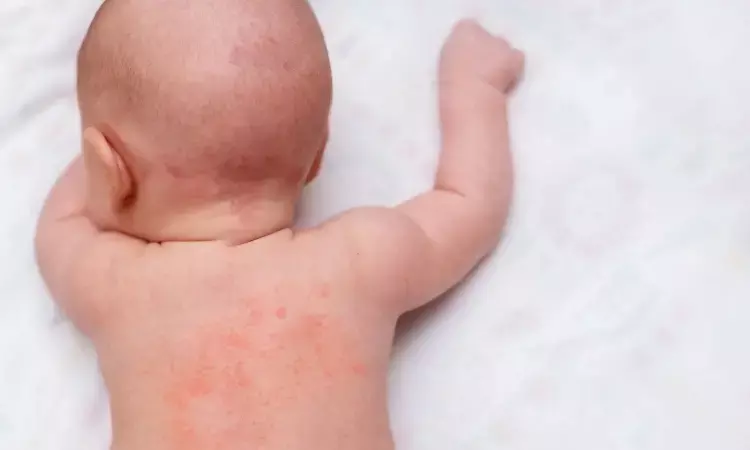- Home
- Medical news & Guidelines
- Anesthesiology
- Cardiology and CTVS
- Critical Care
- Dentistry
- Dermatology
- Diabetes and Endocrinology
- ENT
- Gastroenterology
- Medicine
- Nephrology
- Neurology
- Obstretics-Gynaecology
- Oncology
- Ophthalmology
- Orthopaedics
- Pediatrics-Neonatology
- Psychiatry
- Pulmonology
- Radiology
- Surgery
- Urology
- Laboratory Medicine
- Diet
- Nursing
- Paramedical
- Physiotherapy
- Health news
- Fact Check
- Bone Health Fact Check
- Brain Health Fact Check
- Cancer Related Fact Check
- Child Care Fact Check
- Dental and oral health fact check
- Diabetes and metabolic health fact check
- Diet and Nutrition Fact Check
- Eye and ENT Care Fact Check
- Fitness fact check
- Gut health fact check
- Heart health fact check
- Kidney health fact check
- Medical education fact check
- Men's health fact check
- Respiratory fact check
- Skin and hair care fact check
- Vaccine and Immunization fact check
- Women's health fact check
- AYUSH
- State News
- Andaman and Nicobar Islands
- Andhra Pradesh
- Arunachal Pradesh
- Assam
- Bihar
- Chandigarh
- Chattisgarh
- Dadra and Nagar Haveli
- Daman and Diu
- Delhi
- Goa
- Gujarat
- Haryana
- Himachal Pradesh
- Jammu & Kashmir
- Jharkhand
- Karnataka
- Kerala
- Ladakh
- Lakshadweep
- Madhya Pradesh
- Maharashtra
- Manipur
- Meghalaya
- Mizoram
- Nagaland
- Odisha
- Puducherry
- Punjab
- Rajasthan
- Sikkim
- Tamil Nadu
- Telangana
- Tripura
- Uttar Pradesh
- Uttrakhand
- West Bengal
- Medical Education
- Industry
Cord Blood Levels of IL-31 and CCL17 and cutaneous markers may predict Atopic Dermatitis Risk in Infants: JAMA

Italy: A recent observational study published in JAMA Dermatology has shed light on the potential for cord blood serum levels of specific cytokines to predict the development of atopic dermatitis (AD) in infants.
Researchers investigated the correlation between serum levels of interleukin-31 (IL-31) and CCL17, as well as cutaneous markers and the subsequent emergence of AD. The study suggests that measuring these cytokines at birth could provide valuable insights into identifying newborns at higher risk for developing this common skin condition.
"In this observational study, transepidermal water loss (TEWL) measurements at the anterior cubital fossa were conducted before the onset of clinical signs of AD and showed a correlation with the development of the condition," the researchers wrote.
Atopic dermatitis, a chronic inflammatory skin disorder, affects a significant number of infants and is characterized by symptoms such as itchy, inflamed skin. Identifying early biomarkers for AD could enable earlier interventions and potentially reduce the severity of the condition. Currently, there is no dependable method to identify which newborns are at higher risk of developing atopic dermatitis. Considering this, Angelo Massimiliano D’Erme, Unit of Dermatology, Hospital of Livorno, Livorno, Italy, and colleagues aimed to assess the potential of serological biomarkers—including CCL17 (thymus- and activation-regulated chemokine), CCL18, CCL22, CCL27, IL-31, and thymus stromal lymphopoietin—alongside transepidermal water loss (TEWL) and hydration rate, to predict AD development in infants.
For this purpose, the researchers conducted an observational prospective study involving 40 consecutive full-term newborns from a single university hospital in Pisa, Italy. They assessed the cutaneous markers of these infants at 1, 6, and 12 months of age while analyzing biomarkers from a 10-mL sample of cord blood taken at birth. Data collection was carried out from March to December 2018, with analysis occurring between January and April 2019.
The study aimed to evaluate the levels of serological biomarkers to TEWL and hydration rate and to determine their association with the development of atopic dermatitis during the first year of life.
The study led to the following findings:
- All 40 included infants (68% males) completed the study. At six months, 16 infants presented symptoms and signs of AD (AD group) and 24 did not (non-AD group).
- Infants with AD signs had statistically significant anterior cubital fossa TEWL values at 1, 6, and 12 months of age compared to those without AD signs.
- No statistically significant correlations were observed between the TEWL measured at the anterior part of the knee and the hydration rate at the anterior cubital fossa in the first month in the two groups.
- Regarding blood biomarkers, newborns who later developed atopic dermatitis (AD) had significantly higher levels of CCL17/thymus- and activation-regulated chemokine (median, 716 pg/mL) and IL-31 (median, 212 pg/mL) at birth compared to those who did not develop AD (median, 419 pg/mL for CCL17 and 97 pg/mL for IL-31).
- There were no statistically significant differences in the serum levels of thymus stromal lymphopoietin (median, 105 pg/mL versus 88 pg/mL), CCL18 (median, 1236 pg/mL versus 1255 pg/mL), CCL22 (median, 1032 pg/mL versus 1096 pg/mL), and CCL27 (median, 172 pg/mL vs 120 pg/mL) between the two groups.
In the observational study, TEWL measurements at the anterior cubital fossa were found to precede and correlate with the clinical signs of atopic dermatitis, offering physicians an objective method to assess the risk in newborns and develop additional preventive strategies.
"The analysis of cytokines revealed that measuring CCL17/TARC and IL-31 levels in cord blood could provide valuable insights into identifying newborns at higher risk for AD. These innovative findings are anticipated to enhance the stratification in future intervention studies," the researchers concluded.
Reference:
D’Erme AM, Fidanzi C, Bevilacqua M, et al. Cord Blood Serum Levels of IL-31 and CCL17, Cutaneous Markers, and Development of Atopic Dermatitis. JAMA Dermatol. Published online September 11, 2024.
doi:10.1001/jamadermatol.2024.317
Dr Kamal Kant Kohli-MBBS, DTCD- a chest specialist with more than 30 years of practice and a flair for writing clinical articles, Dr Kamal Kant Kohli joined Medical Dialogues as a Chief Editor of Medical News. Besides writing articles, as an editor, he proofreads and verifies all the medical content published on Medical Dialogues including those coming from journals, studies,medical conferences,guidelines etc. Email: drkohli@medicaldialogues.in. Contact no. 011-43720751


